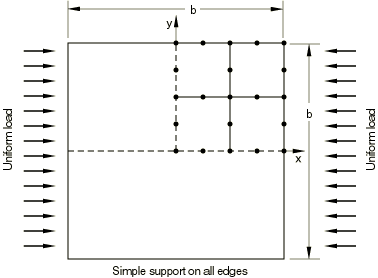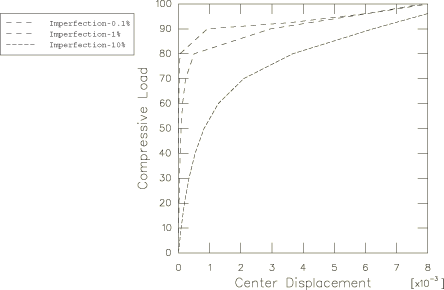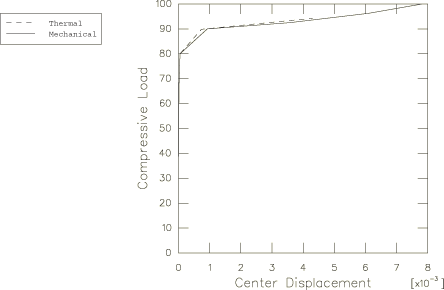The next phase of a typical collapse analysis is to perform a
load-displacement analysis to ensure that the eigenvalue buckling prediction
already obtained is accurate and, at the same time, to investigate the effect
of initial geometric imperfection on the load-displacement response. In this
way concerns about imperfection sensitivity (unstable postbuckling response)
can be addressed. The eigenvalue analysis is useful in providing guidance about
mesh design for these more expensive load-displacement studies: mesh
convergence studies can be performed as part of the eigenvalue analysis, which
is usually significantly less expensive than the load-deflection analysis.
For the load-displacement analysis the perfect geometry must be “seeded”
with an imperfection to cause it to collapse. It is possible that a problem run
with perfect geometry may never buckle numerically at reasonable load levels
because the model has absolutely no prebuckled displacement in the postbuckled
mode and, thus, no ability to switch to that mode. Presumably an imperfection
in the form of the buckling mode would be the most critical. In this example,
for simplicity, we use instead a bilinear imperfection:
So long as the imperfection contains the mode into which the structure
wishes to collapse, it is presumed that any imperfection will provide the
necessary perturbation of the solution.
The imperfection magnitude,
is taken as 0.1%, 1%, and 10% of the plate thickness. Since we expect a buckle
at a load of about 90.4, the edge load is applied by requesting that the load
be increased monotonically up to a value of 100, starting with an increment of
10. Normally the Riks method would be chosen if the postbuckling response is
unstable. It is not necessary for this case.
In all cases where a sudden loss of stiffness is expected (as here, when the
imperfection is very small) it is essential that equilibrium be satisfied
closely; otherwise it is possible for the solution to fail to switch to the
alternate branch of the solution. The default equilibrium tolerances used in
Abaqus
are rather tight by engineering standards, as experience shows that less
demanding equilibrium control may fail to pick up the buckle in the case of
almost perfect geometry.


